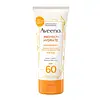What's inside
What's inside
 Key Ingredients
Key Ingredients

 Benefits
Benefits

 Concerns
Concerns

 Ingredients Side-by-side
Ingredients Side-by-side

Butyl Methoxydibenzoylmethane 3%
UV AbsorberHomosalate 13.5%
Skin ConditioningEthylhexyl Salicylate 5%
UV AbsorberOctocrylene 10%
UV AbsorberWater
Skin ConditioningButyloctyl Salicylate
Skin ConditioningGlycerin
HumectantAlcohol Denat.
AntimicrobialSilica
AbrasiveCaprylyl Methicone
Skin ConditioningAluminum Starch Octenylsuccinate
AbsorbentDimethicone
EmollientPolyurethane-62
Phenoxyethanol
PreservativePentylene Glycol
Skin ConditioningSodium Acryloyldimethyltaurate/Vp Crosspolymer
Emulsion StabilisingAcrylates/Dimethicone Copolymer
Skin ConditioningGlyceryl Stearate
EmollientChlorphenesin
AntimicrobialStyrene/Acrylates Copolymer
Parfum
MaskingDisodium EDTA
Trideceth-6
EmulsifyingAvena Sativa Kernel Extract
AbrasiveSodium Hydroxide
BufferingButyl Methoxydibenzoylmethane 3%, Homosalate 13.5%, Ethylhexyl Salicylate 5%, Octocrylene 10%, Water, Butyloctyl Salicylate, Glycerin, Alcohol Denat., Silica, Caprylyl Methicone, Aluminum Starch Octenylsuccinate, Dimethicone, Polyurethane-62, Phenoxyethanol, Pentylene Glycol, Sodium Acryloyldimethyltaurate/Vp Crosspolymer, Acrylates/Dimethicone Copolymer, Glyceryl Stearate, Chlorphenesin, Styrene/Acrylates Copolymer, Parfum, Disodium EDTA, Trideceth-6, Avena Sativa Kernel Extract, Sodium Hydroxide
Ethylhexyl Methoxycinnamate 3%
UV AbsorberTitanium Dioxide 22.85%
Cosmetic ColorantAluminum Hydroxide
EmollientButyloctyl Salicylate
Skin ConditioningC12-15 Alkyl Benzoate
AntimicrobialCaprylyl Methicone
Skin ConditioningCI 77491
Cosmetic ColorantCI 77492
Cosmetic ColorantCI 77499
Cosmetic ColorantCopernicia Cerifera Wax
Dimethicone
EmollientEthylhexylglycerin
Skin ConditioningHydrogenated Polydecene
EmollientIsononyl Isononanoate
EmollientIsopropyl Myristate
EmollientIsopropyl Titanium Triisostearate
EmollientIsostearic Acid
CleansingKaolin
AbrasiveMethyl Methacrylate Crosspolymer
Microcrystalline Wax
Emulsion StabilisingPhenoxyethanol
PreservativePhytosteryl/Behenyl/Octyldodecyl Lauroyl Glutamate
Skin ConditioningPolyethylene
AbrasivePolyhydroxystearic Acid
EmulsifyingPropylene Carbonate
SolventStearalkonium Hectorite
Gel FormingTocopherol
AntioxidantEthylhexyl Methoxycinnamate 3%, Titanium Dioxide 22.85%, Aluminum Hydroxide, Butyloctyl Salicylate, C12-15 Alkyl Benzoate, Caprylyl Methicone, CI 77491, CI 77492, CI 77499, Copernicia Cerifera Wax, Dimethicone, Ethylhexylglycerin, Hydrogenated Polydecene, Isononyl Isononanoate, Isopropyl Myristate, Isopropyl Titanium Triisostearate, Isostearic Acid, Kaolin, Methyl Methacrylate Crosspolymer, Microcrystalline Wax, Phenoxyethanol, Phytosteryl/Behenyl/Octyldodecyl Lauroyl Glutamate, Polyethylene, Polyhydroxystearic Acid, Propylene Carbonate, Stearalkonium Hectorite, Tocopherol
 Reviews
Reviews

Ingredients Explained
These ingredients are found in both products.
Ingredients higher up in an ingredient list are typically present in a larger amount.
Butyloctyl Salicylate is a chemical UV filter structurally similar to octisalate. It is a photostabilizer, SPF booster, emollient and solvent. This ingredient helps evenly spread out ingredients.
According to a manufacturer, it is suitable for pairing with micro Titanium Dioxide, Zinc Oxide, and pigments.
Photostabilizers help stabilize UV-filters and prevents them from degrading quickly.
Learn more about Butyloctyl SalicylateCaprylyl Methicone is a type of silicone.
It helps soften and soothe the skin by creating a thin film on top. This film helps trap moisture, keeping your skin hydrated.
Dimethicone is a type of synthetic silicone created from natural materials such as quartz.
What it does:
Dimethicone comes in different viscosities:
Depending on the viscosity, dimethicone has different properties.
Ingredients lists don't always show which type is used, so we recommend reaching out to the brand if you have questions about the viscosity.
This ingredient is unlikely to cause irritation because it does not get absorbed into skin. However, people with silicone allergies should be careful about using this ingredient.
Note: Dimethicone may contribute to pilling. This is because it is not oil or water soluble, so pilling may occur when layered with products. When mixed with heavy oils in a formula, the outcome is also quite greasy.
Learn more about DimethiconePhenoxyethanol is a preservative that has germicide, antimicrobial, and aromatic properties. Studies show that phenoxyethanol can prevent microbial growth. By itself, it has a scent that is similar to that of a rose.
It's often used in formulations along with Caprylyl Glycol to preserve the shelf life of products.